
A new study has now quantified the solar cell energy output loss occurring around the world as a result of air pollution and dust — bringing one of the most serious limitations of solar photovoltaic reliance in the more polluted parts of the world to the forefront, and giving us a better view of what exactly is going on.
Going by the new study, solar cell output in some parts of the world is cut by over 25% as a result of airborne particles (particulate air pollution) and dust.
The regions that are the most affected according to the study are also some of those that have installed the most solar photovoltaic (PV) capacity in recent years: India, China, and parts of the Middle East.
“My colleagues in India were showing off some of their rooftop solar installations, and I was blown away by how dirty the panels were,” commented Michael Bergin, professor of civil and environmental engineering at Duke University and lead author of the study. “I thought the dirt had to affect their efficiencies, but there weren’t any studies out there estimating the losses. So we put together a comprehensive model to do just that.”
The press release provides more: “With colleagues at the Indian Institute of Technology-Gandhinagar and the University of Wisconsin at Madison, Bergin measured the decrease in solar energy gathered by the IITGN’s solar panels as they became dirtier over time. The data showed a 50% jump in efficiency each time the panels were cleaned after being left alone for several weeks.
“The researchers also sampled the grime to analyze its composition, revealing that 92% was dust while the remaining fraction was composed of carbon and ion pollutants from human activity. While this may sound like a small amount, light is blocked more efficiently by smaller man-made particles than by natural dust. As a result, the human contributions to energy loss are much greater than those from dust, making the two sources roughly equal antagonists in this case.
“The manmade particles are also small and sticky, making them much more difficult to clean off,” noted Bergin. “You might think you could just clean the solar panels more often, but the more you clean them, the higher your risk of damaging them.”
Of course, the air pollution that is in the air itself also reduces solar cell output — it’s not just the buildup on the surface of the solar panel that does. To assess the effects of the air pollution itself, the researchers enlisted the help of the professor of climate sciences at Duke (and an “expert” in the use of the NASA GISS Global Climate Model), Drew Shindell.
The press release continues: “Because the climate model already accounts for the amount of the sun’s energy blocked by different types of airborne particles, it was not a stretch to estimate the particles’ effects on solar energy. The NASA model also estimates the amount of particulate matter deposited on surfaces worldwide, providing a basis for Bergin’s equation to calculate how much sunlight would be blocked by accumulated dust and pollution.
“The resulting calculations estimate the total loss of solar energy production in every part of the world. While the United States has relatively little migratory dust, more arid regions such as the Arabian Peninsula, Northern India and Eastern China are looking at heavy losses — 17% to 25% or more, assuming monthly cleanings. If cleanings take place every two months, those numbers jump to 25% or 35%.”
Local variations can of course be significant, though, it should be remembered. For instance, if there are construction zones nearby then the amount of dust in the air will be significantly higher than would otherwise be the case. Seasonal variation can be significant as well.
As far as differences between different regions, they are about what you’d expect — dust is more of a problem on the Arabian Peninsula than air pollution is, and the reviser is true in India and China, where the air pollution problem is significant and still fast growing.
Bergin commented on that: “China is already looking at tens of billions of dollars being lost each year, with more than 80% of that coming from losses due to pollution. With the explosion of renewables taking place in China and their recent commitment to expanding their solar power capacity, that number is only going to go up.
“We always knew these pollutants were bad for human health and climate change, but now we’ve shown how bad they are for solar energy as well. It’s yet another reason for policymakers worldwide to adopt emissions controls.”
That’s something that is easier said than done considering the degree to which much of modern industrial culture relies upon cheap fossil fuel energy — air pollution or emissions controls of course drive up the price of energy use notably.
It should probably be remembered here that, while renewable energy use has been growing rapidly in recent years that it still represents only a very small part of the global energy mix. In general, renewables have simply increased in concert with an energy system that is itself growing rapidly — fossil fuel use has remained for the most part steady. In other words, renewables have to date simply been mostly additive to the energy system — not subtractive of fossil fuel reliance, due to growing energy use globally.
If extreme anthropogenic climate change is to be avoided to any real degree, then this will need to change (rapidly) in the coming years.
The new study was detailed in a paper published in Environmental Science & Technology Letters.
Source: cleantechnica.com



